The piece of the month of January 2019
UNPUBLISHED PHOTOGRAPHS OF DOMINGO ERNETA. ONE OF THE FIRST PHOTOGRAPHIC PROGRAMS OF STUDY OF PAMPLONA.
José Ignacio Riezu Boj
University of Navarra
The present work intends to show several photographs signed by a hitherto unknown photographer in the early days of photography in Pamplona. It consists of 6 photographs taken in Carte de Visite (CDV) format, all of which have the name of the photographer Domingo Erneta and the town of Pamplona printed on both the front and back of the cardboard support.
To date the only review we have about this photographer is a small reference letter and a photograph published in the book Navarra / Fotografía de Carlos Cánovas provided by this writer. In attempts to identify this photographer I found a Jesuit with the same name who could fit the dates of our character. After speaking with several Jesuits - I must thank Fathers Manuel Revuelta González, Wenceslao Soto Artuñedo, Ricardo Sada Aldaz and especially Father Isidro Sans, archivist of Loyola, for their kindness and diligence - I obtained the Jesuit' s ego from file of Loyola. It is an autobiographical document that submission the candidate wrote when he entered the novitiate of the Society of Jesus, in which he explains his motivations for joining the order (photo 1). The text makes it clear that we are talking about the same character. The manuscript begins with a short biography of candidate and ends with his handwritten signature (photo 2):
I, Domingo Erneta, Spanish, was born in Lecumberri, Bishopric of Pamplona, Province of Navarre, on February 24, 1841 of legitimate parents Juan Angel and Maria Barcibar alive. I stayed with my parents until I was 19 years old. Then I studied grammar and Philosophy; then I went to Pamplona and learned the photographer's official document for five years. Finally, desirous of a better life, I aspired to enter the Society of Jesus where I was received by Father Eugenio Labarta, Provincial Superior of the Province of Castile. I came to this novitiate in Loyola on March 3, 1865, where I remained as a pretender until April 26, 1865, when I began my novitiate....
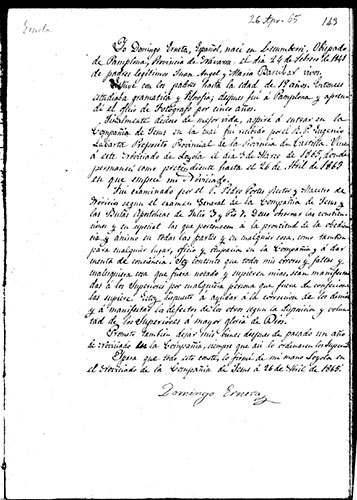

(1) Ego of Domingo Erneta (file of the Society of Jesus in Loyola). (2) signature of Domingo Erneta in his Ego.
Biography of Domingo Erneta Baraibar
Our photographer was born in Lecumberri on February 24, 1841, at 10 o'clock in the morning. He was baptized the following day with the name of José Domingo Erneta, son of Juan Ángel Erneta and Juana Bautista de Baraibar, he from Lecumberri and she from Eguaras. Paternal grandparents: Domingo Erneta, native of Leiza, and Joaquina Ochotorena, native of Lecumberri. Maternal grandparents: Vicente de Baraibar, native of Eguaras, and Francisca de Cestona, native of Lecumberri. Godparents: Domingo Echarri and Josefa Baraibar, from Lecumberri and Eguaras, respectively (I have to thank Professor Ricardo Fernández Gracia for these data ).
Until the age of 19 he studied grammar and Philosophy in Lecumberri. In 1860 he moved to Pamplona to study official document as a photographer for 5 years. In March 1865 he went to Loyola and on April 26, 1865, at the age of 24, he entered the novitiate of the Society of Jesus in Loyola. In the following years he appears in the catalogs of each course as a photographer, among other occupations. Thus, in the Catalog of the 1865-66 course he appears as: "Dominicus Erneta, Sart. Photograph. 26 april. 1865". In the Catalog of 1867-68 he continues at Loyola with three positions: photographer, housework, and alarm clock in the morning. The revolution of 1868 suppressed the Society and our photographer settled in France, appearing in the catalogs as partner (secretary) of Father Provincial Philippe Gomez. In 1871, with the restoration of Amadeo of Savoy, he returned to Spain in charge of one of the Jesuit residences in Madrid. With the proclamation of the first republic, in 1873, he returned to France, to the residency program of Bayonne, in charge of the house(ad domestica, domestic services). He made his incorporation final in the Society of Jesus by his last vows on August 15, 1875 in Poyanne (France). In 1880 he was assigned to the Province of Toledo. In 1882 he participated in the foundation of high school San Estanislao de Kostka in the Barrio del Palo in Malaga. He remained in this high school until 1916, when he was transferred ill to Ciempozuelos, where he died on November 4, 1916, at 75 years of age and 51 years of religious life in the Society of Jesus (data provided by Brother Wenceslao Soto Sevilla).
Photographic studio in Pamplona
Everything suggests that this photographer, at least in the last years of his stay in Pamplona, was able to set up a small photographic studio. As he himself has informed us, he was in Pamplona for 5 years. In the guide of Pamplona of 1863 he does not appear, and in March of 1865 he was already in Loyola; this gives us a narrow band between the years 1864 and the first months of 1865 in which he could dedicate himself to photography professionally. There are several indications that make us think that he could have set up a photographic business. The decorative materials (carpets, balustrades, curtains, chairs, columns, pedestals, curtain rails, etc.) that appear in Erneta's photographs are typical of the photographic programs of study of the early 1960s. They are characterized by few resources and little variation in the sets. These characteristics allow, with some ease, to identify the programs of study of these years. Thus, the decorative elements that appear in the few photographs that have come down to us from Domingo are different from those that appear in the other establishment that we know operated in Pamplona in those years, that of Leandro Desages. Another clue is provided by the use of cardboard supports with a print that reads "FOTOGRAFÍA de Domingo Erneta, Pamplona", typical of the programs of study of that time.
With whom did he learn the official document? At the age of 19 (1860) our character moved to Pamplona to study the photographer's official document . The only known photographic establishment at that time, as we have already said, is that of Leandro Desages, which is installed in the Baños de Palacio, near what was then the Capitanía General, today file of Navarra. The first quotations of this photographer are from 1863 in the guide of the city of Alexandria (P. Alexandria, El pamplonés. guide of the city and guide of curiosities) and in 1864 registering in the French society of photography (Bulletin de la Société française de photographie, May 1864), although there are photographs of him dated in 1859 (Catalog of the exhibition PRIMEROS TIEMPOS DE LA FOTOGRAFÍA EN ZARAGOZA. Carte de Visite" and "Cabinet Card" formats). But in Pamplona there were also other people who practiced photography at that time, such as the local photographer Babil Moreno, ecclesiastic and Full Professor of physics in the seminar of Pamplona that Professor Ricardo Fernández Gracia has recently discovered for us, or the Parisian itinerant J. Harreguy, announced on May 1 and April 8, 1860 in the newspaper La joven Navarra. We must also mention the portrait painters, father and son, Miguel Sanz and Mariano Sanz. In fact, the first and only known daguerreotype of Pamplona is signed by the painter and director of the normal school of painting of Pamplona Miguel Sanz Benito. His son, Mariano Sanz Tarazona, painter and director of the same school, also seems to have signed some photographs in the early date of 1855.
We do not know for sure with whom our photographer learned the official document , although we are inclined to think of Leandro Desages. Both Leandro's photography and framing business advertised with Leandro and company, so we can venture that there were more people working with Leandro. Could one of them be our young Domingo?
Characteristics of Domingo Erneta's photographs
At present we know of 6 photographs by this photographer, all of them in CDV format attached to a similar secondary cardboard. This one presents, on the obverse, on the lower left side, printed in red color, the name and surname of the photographer, in capital letters, followed by the abbreviation of photographer in lower case letters. The front side also has a large rectangle printed in red to frame the albumin. The back (photo 3) shows in the center the red printing of the photographic studio; in capital letters appears the name and surname of the photographer surrounded by the word "fotografía" in the upper part and "Pamplona" in the lower part. The only ornament that stands out are the small scrolls that come out of some of the letters, mainly the first and last letters of each word. This ornament subject , although more ornate, can also be seen in some of the supports of Leandro Desages' studio, which suggests its origin in a local printing press.
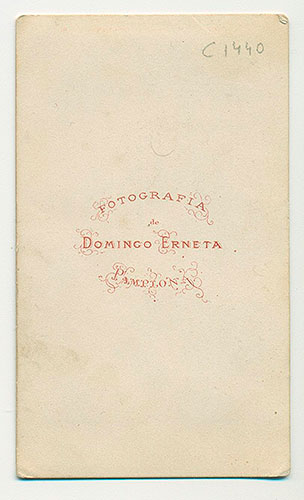
(3) Reverse of a CDV of Domingo Erneta.
Four of Erneta's photographs depict ecclesiastics. All of them present very elaborate poses, showing the subject turned and looking to his left, with his hands carefully placed, either holding a book or holding some part of his attire. Three religious (photos 4, 5 and 6) appear seated, while the other is standing, resting a book on a small table and holding his cloak or mantle with the other hand (photo 7). Two of the photographs (photos 5 and 6) are oval portraits, while the other two are of rectangular format (photos 4 and 7). One of the clergymen appears to be wearing the vestments of the Pamplona cathedral chapter (photo 5). Two photographs portray the same priest (photos 6 and 7).

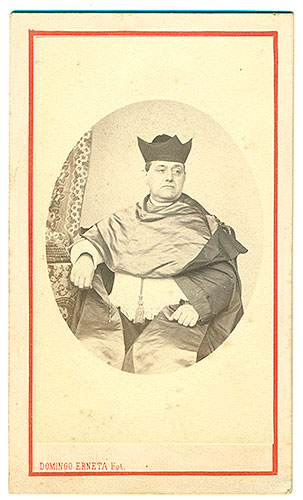
(4) CDV of Domingo Erneta. Ecclesiasticus. (5) CDV of Domingo Erneta. Ecclesiastic.
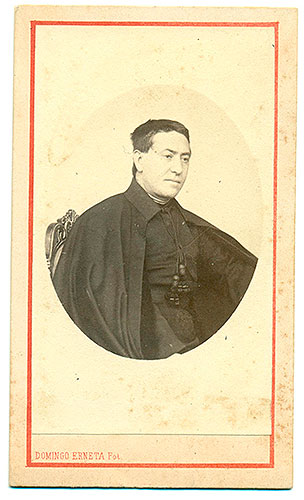
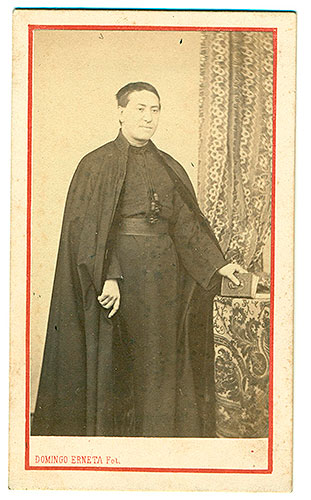
(6) CDV of Domingo Erneta. Ecclesiasticus. (7) CDV of Domingo Erneta. Ecclesiastic.
The fifth snapshot (photo 8) portrays a woman seated, looking at the viewer with her arms crossed. The young woman wears a wide dress and carries on her head a hat subject hood. The last photograph (photo 9) sample is of a magnificently dressed infantry officer of the Spanish army. He is standing, facing the viewer, leaning on a chair on which he has placed the ros. He wears a frock coat with a belt and a large buckle around his waist. It covers the shoulders with a slavina withdrawn to the back, tied by a cord that hangs in front and tightened to the neck by the metallic gola, insignia of the officers. He also wears pants and boots. He carries a saber, which he rests on the carpet of the studio, girded with a belt that hangs from the right shoulder across the chest. He displays a star and a gallon on the cuff, a sign of the military rank he holds, probably second lieutenant or ensign.
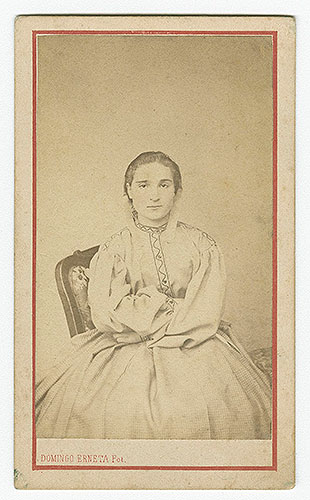
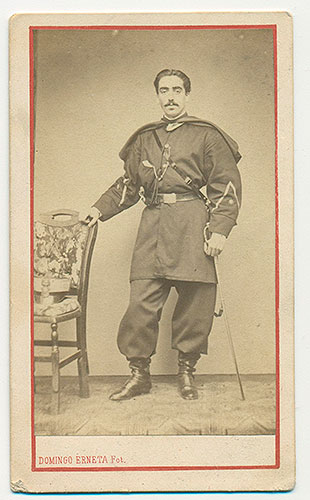
(8) CDV of Domingo Erneta. Lady. (9) CDV of Domingo Erneta. Military.
The photographs studied are all typical photographs of this period, which portray in elegant and studied poses theaverage and high class of Pamplona, demonstrating an important internship and knowledge of our young photographer in the newborn art of photography.
SOURCES AND BIBLIOGRAPHY
file of the Society of Jesus in Loyola.
file Diocesano de Pamplona, caja 1285, libro de Bautizados de la Parroquia de Lecumberri 1811-1875, p. 215.
ALEJANDRÍA, P., El pamplonés. guide de la ciudad y guide de curiosidades, Pamplona, Sisto Díaz Espada, 1863, pp. 65 and ff.
Bulletin de la Société française de photographie, May 1864.
CÁNOVAS, C., Navarra / Fotografía, Pamplona, Gobierno de Navarra, 2012, pp. 42-43.
Catalog from the exhibition: EARLY TIMES OF PHOTOGRAPHY IN ZARAGOZA. Carte de Visite" and "Cabinet Card" formats, conference room de exposiciones de Cajalón, from June 10 to July 31, 2010, Zaragoza, p. 57.
FERNÁNDEZ GRACIA, R., "By way of prologue: some reflections on the transformation of Marian images and their staging for worship", Montes y Valles, Santuarios de Tierra Estella, Cofradía de Nuestra Señora del Puy de Estella, Cofradía de Nuestra Señora de Codés and Cofradía de San Gregorio Ostiense, 2017, pp. 18-19.
